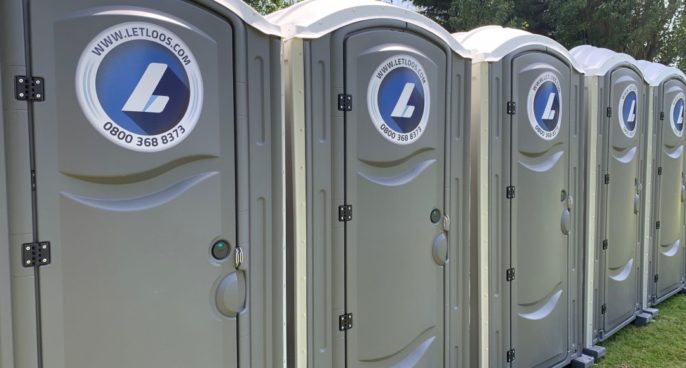
If you’re in charge of booking a portable toilet for a Liverpool construction site, you’re going to need to be familiar with construction site requirements and rules. Alongside taking stock of how much you can expect to pay for portable toilets on a construction site, you’ll also need to factor in any demand for welfare facilities.
Coordinating welfare and sanitation facilities for a Liverpool construction site therefore requires some forethought, and this article is designed to outline exactly what you’ll need to provide for your workers according to legal requirements laid out by the government’s Health and Safety Executive.
From determining whether flushing or chemical toilets are suitable for your site, to considering the need for mobile welfare units containing essentials like hotwash facilities, we’re here to take the stress out of your search for Liverpool construction site toilets and sanitary facilities.
Table of Contents
- 1 The role of the HSE and CDM 2015
- 2 Schedule 2 – Construction (Design and Management) Regulations 2015
- 3 HSE compliance: what to consider when organising portable toilets
- 4 How many portable toilets on Liverpool Construction Site toilet are necessary?
- 5 Other considerations for toilets and washing facilities on construction sites
- 6 Find out how LetLoos can help you secure portable toilets for your construction site
The role of the HSE and CDM 2015
Before you begin to tally up the number and type of sanitary and welfare facilities your construction site demands, you need to understand your position as an employer or site manager, and any legal requirements you have towards your workers. Doing so necessitates understanding the role of the HSE, as well as critical acts like the CDM 2015.
The HSE is an acronym for the Health and Safety Executive. This is the United Kingdom’s national regulator for workplace health and safety, and is designed to mitigate and prevent work-based death, injury, and ill health throughout the country. As an employer, it’s essential for you to be on top of the responsibilities that you have towards your employees. HSE lays these out clearly, so it’s critical that you become familiar with their legislated safe working practices.
As a regulator, the HSE operates by way of various acts, and one of the most important for construction sites is Schedule 2 of the Construction (Design and Management) Regulations 2015 or CDM 2015. This lays out the duties that employers have to fulfil in order to be compliant with UK law. One of these is the provision of portable toilets and welfare facilities on construction sites.
If your job is to establish how many portable toilets on your Liverpool construction site that you need, then you’ll need to understand the minimum requirements under the CDM 2015.
Schedule 2 – Construction (Design and Management) Regulations 2015
Everyone working on a construction site needs appropriate access to washing facilities and toilets as set out in The Construction (Design and Management) Regulations 2015.
Schedule 2 of this regulation refers specifically to the minimum facilities needed depending on the type of site and the number of people.
The main elements of Schedule 2 include:
- Sanitary provisions
- Washing facilities
- Drinking water
- Changing rooms
- Facilities for rest
When arranging adequate toilet provisions, focusing on the toilets and washing facilities subsections will guide you on the necessary regulations.
HSE compliance: what to consider when organising portable toilets
If you’ve been tasked with establishing how many portable toilets a Liverpool construction site needs, there are a number of factors you need to consider when trying to find the right builders’ site toilets in Liverpool, as well as previously discussed rules and regulations to which you must adhere. You can learn more about the welfare requirements of construction sites elsewhere on our blog.
When choosing portable toilets for your Liverpool construction site, you’ll need to ascertain whether you have access to a mains water supply. It’s also worth noting that suitable washing facilities and showers may be required depending on the nature of the work or for health reasons. This requires running water – unless suitable alternatives are available nearby.
In the instance of running water via a mains supply being unavailable, there must be an adequate provision of water by employers, which may require the hiring of a water tank.
When you’re organising sanitary and welfare facilities on a construction site, below are the provisions that an employer is expected to provide according to Schedule 2 of the CDM 2015.
Toilets
There are two main types of portable toilets available on construction sites. Below, we describe the process of establishing how many site toilets you may need. Still, you’ll also need to consider what kind of facilities you want to – or are able to – provide.
Flushing toilets
Flushing toilets are preferable, as they can be attached to a mains water supply and sewage system. Alternatively, you can opt for portable toilets with a built-in water supply and draining tanks.
Chemical toilets
Portable chemical toilets are another option for construction sites and tend to be typical on less permanent, smaller jobs. They are also suitable if flushing toilets cannot be provided due to location.
Washing facilities
Schedule 2 of the CDM 2015 describes the required provisions of washing facilities by employers on construction sites.
All facilities must be conveniently located, proximate to all sanitary facilities, and fulfil the requirements of Regulation 21, which includes suitable and appropriate ventilation, cleanliness, and lighting. Hot and cold, or warm, running water is also expected, and there should be a washbasin for workers to wash their hands, face, and forearms for work that is considered either strenuous, hazardous, or potentially resulting in contamination.
Portable toilets may not have adequate washing facilities due to the confined space. The small sink and hand sanitiser are appropriate for sanitary provisions. But larger sinks need to be supplied to allow suitable forearm washing if required.
Showers may also be required depending on the work. Hand washing should also not be carried out in places where workers eat or drink due to the risk of contamination.
How many portable toilets on Liverpool Construction Site toilet are necessary?
Under the guidance of The Construction (Design and Management) Regulations 2015 (CDM 2015), you need to be operating within specific parameters when coordinating the number of toilets (flushing or portable) for any construction site – and Liverpool is no exception!
The number of toilets required on a construction site depends on a few factors, such as how many workers you have and the split of men to women.
To give you an indication of the number of toilets you need, take a look at Tables 1 and 2 in the Approved Code of Practice and guidance in the Workplace (Health, Safety and Welfare) Regulations 1992. While this doesn’t apply specifically to construction sites, it gives you an idea of how many are needed.
For example, the ACOP states where both men and women are working, you need one cubicle and one washbasin for every 1 to 5 workers. Therefore, as the number of employees increases, so too does the number of cubicles and washbasins that are required to be HSE compliant.
For sites with 6 to 25 workers, 2 cubicles and 2 washbasins are required. For 25 to 50 workers, 3 cubicles and 3 washbasins are required. Workplaces of 51 to 75 employees require 4 cubicles and washbasins, and workplaces of 76 to 100 workers require 5 cubicles and 5 washbasins. Remember, these are the numbers required for mixed workforces. The guiding principle is that an additional toilet and washbasin be provided for every 25 people above a total of 100.
Alternative principles apply when considering the need for urinals for men, either in a male-only construction site, or as an addition to the cubicles and washbasins provided above. For 1 to 15 male workers, there should be 1 cubicle and 1 urinal. For 16 to 30 male workers, there should be 2 cubicles and 1 urinal. The guiding principle is for an additional cubicle to be provided for every 50 men, provided that at least an equal number of urinals are available.
However, if you are using chemical toilets, the BSI standard (BS6465-1-2006) recommends that there should be one portable toilet for every seven people for a typical 40-hour working week. But this number also needs to take into account the frequency of use and how often they are emptied.
If portable toilets are used more often, then servicing and emptying may need to be done more regularly than the typical once-a-week as part of the hire contract.
Other considerations for toilets and washing facilities on construction sites
Gender provisions
It is not a requirement to provide separate facilities for men and women. However, there must be a lockable cubicle that is separate from the urinals. Men and women can share toilets. But, there must be a sanitary waste disposal unit available for female construction workers.
The same applies to washing facilities. Men and women can use the same sinks for hand washing. There may also be unisex showers as long as there is a lockable cubicle that one person uses at a time.
Distance to toilets
Workers should be able to access toilets easily and not have to walk a long distance to use them. Construction sites are high-risk areas and to minimise risk to health and safety, placing portable toilets in easy-to-reach places is necessary.
It’s also helpful to plan sanitary provision layouts according to where they are most needed. For example, some areas of the site may have more workers than others. So spacing them out accordingly will reduce people waiting to use the facilities when others are free in low-use areas.
Providing easily accessible toilets also ensures workers don’t urinate outside of this facility. This is unsanitary and unacceptable behaviour on construction sites, but unfortunately, it sometimes happens. However, it can be avoided if adequate facilities are in place.
Cleaning provisions
All site toilets require thorough cleaning, depending on the usage. Portable toilets often have this service provided as part of the hire contract. However, more frequent cleaning may be needed, especially if the construction site is muddy. Additional cleaning is required for portable toilets depending on how many people use them and the nature of the work carried out on site.
Managing consumables
Consumables such as toilet paper, hand wash, paper towels, and so on, run out quickly on a busy construction site. Therefore, it is vital to keep on top of monitoring consumables so they don’t run out.
Availability of toilets
Alongside having the correct number of portable toilets at your construction site, you need to ensure they are all available during working hours.
Due to the number of people using them, blockages or issues may inevitably occur during the hire period. However, sorting these quickly is essential so workers are not waiting around to use the facilities.
If you experience problems with chemical toilets, contact the hire company, and they will send someone to rectify the issue as quickly as possible. Having toilets out of order for extended periods will affect the number available, and this could raise issues with construction health and safety regulations.
Ventilation and lighting
Schedule 2 of the CDM 2015 also states that toilet facilities need to be ventilated and well-lit. It’s important to ensure this is the case, especially during the winter months when it is darker in the mornings and early evenings when workers are still on the clock.
Find out how LetLoos can help you secure portable toilets for your construction site
Ensuring you have the right number of portable toilets for your construction site ensures you are compliant with the HSE. Plus, it benefits workers as they have access to clean facilities at all times.
If you have any questions regarding how many portable toilets your Liverpool construction site might need, or want to find out what other washing facilities your site may require, contact LetLoos today.
We’ll work with you to ensure that your site is HSE compliant and can address any concerns you may have about doing so. LetLoos make construction site toilet hire easier.



